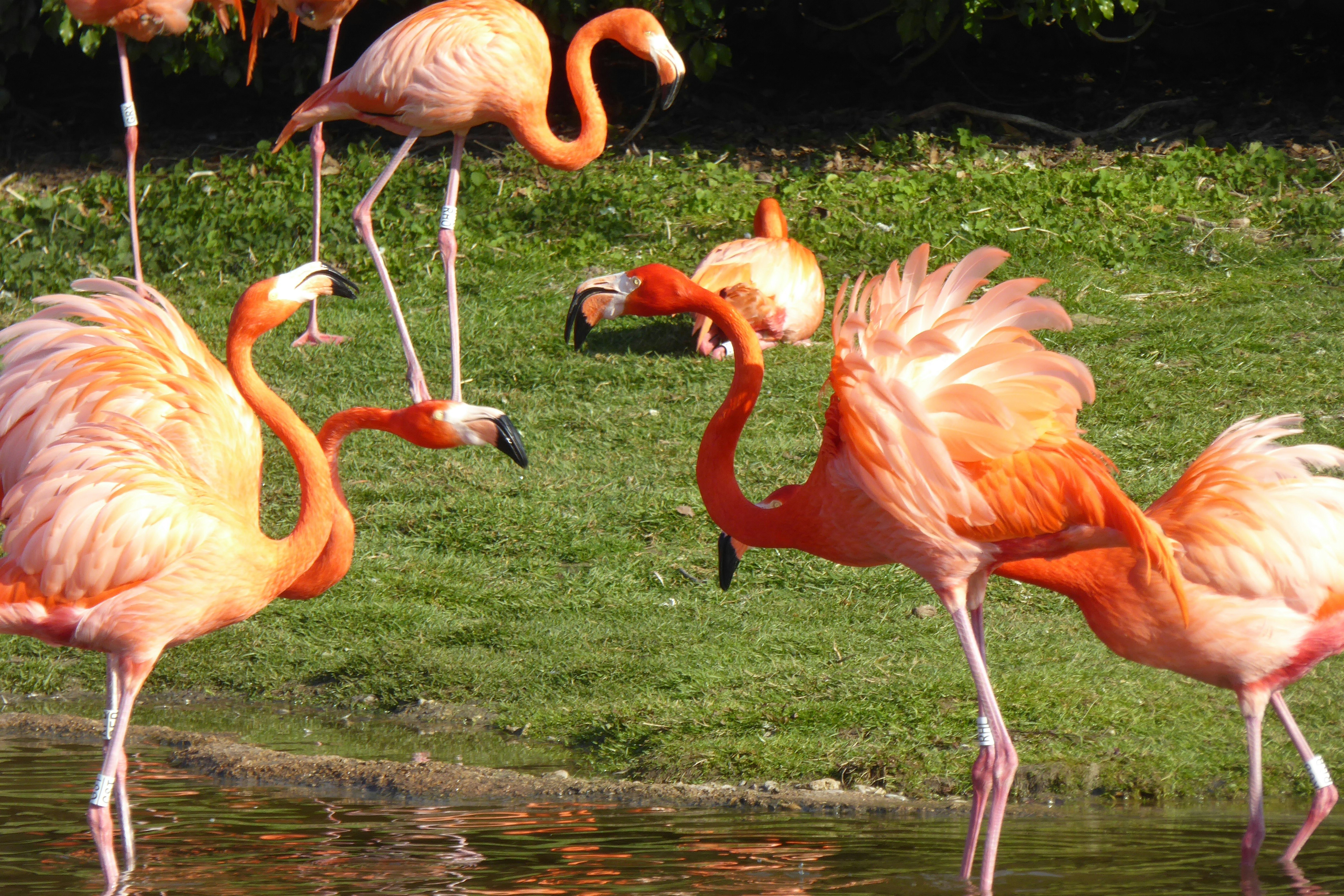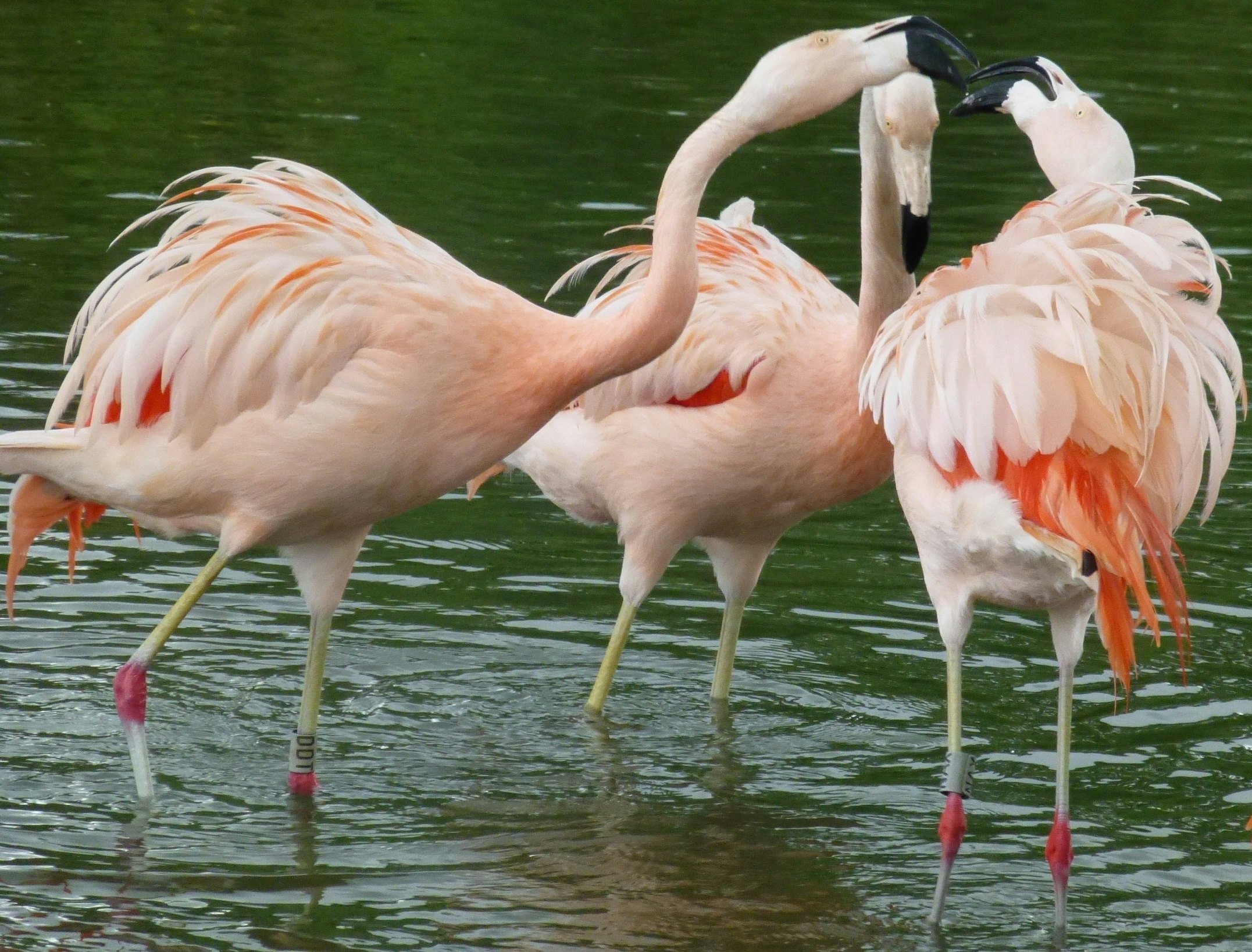
In human psychology, the big five personality traits constitute essential characteristics that describe how one muddles their way through the world. Everyone falls on a spectrum for each of the five traits: conscientiousness, agreeability, neuroticism, openness, and extroversion. These attributes form the acronym C.A.N.O.E. (or O.C.E.A.N.)
Thanks to animal behavior scientist Paul Rose, flamingos have their version, the big three: aggressiveness, openness, and submissiveness. Unfortunately, those don’t make for a great acronym. (Believe me, I tried.)
Rose, an animal psychology professor at the University of Exeter, and his team developed this metric in 2014 after observing two flocks of these leggy birds. When Rose started this research, he says that it was assumed flamingos only maintained loose connections with other members of the flock. However, his team’s findings intimate that these birds have distinct personalities as well as relationships.
Today, his team published a paper in the journal Scientific Reports that digs into the potential inner life of the flamingo, and the cliques formed in a flock.

Birds of a Feather...
Flamingos, according to Rose, are what’s called a colonial obligate species, which means they do everything as a flock. Think of those groups in school or a bar who travel in a blob, ordering drinks and peeing together. Flamingos are like that, except their flocks can be as large as a million birds.
Within the larger flock, these birds form subgroups. When he began observing these birds in 2012, Rose suspected these cliques weren’t arbitrary. He noticed that birds with similar behavior patterns flocked together. He decided to quantify those behaviors.
“It was really fascinating to see how complex the social lives of these animals were,” Rose tells Inverse.
By the way, a group of flamingos is only called “flamboyance” when they’re displaying, i.e., vying for a mate. Otherwise, they go by the comparatively bland collective noun “stand.”
Rose and his team also noticed pairs of flamingos. While sometimes a bird’s mate served as its friend, others had a mate as well as another flamingo with whom they did everything — eating, foraging, preening. Some flamingos, however, didn’t stick to a single group and were “social butterflies.”
What’s more, the bonded birds he noticed seemed to have similar behavior patterns. These buddies weren’t only for the company, but also for support in social situations. If two flamingos got into an argument over food and began harassing each other, the flamingo who had a ride-or-die show up for support was more likely to win.
Rose’s term for these pairs? Flamingo friends.

Protect Flamingos Friends at All Costs
There are six living species of flamingo, four of which “have a kind of conservation concern attached to them,” Rose tells Inverse. While flamingos may not be in dire straits at the moment, at least three of these species’ populations are decreasing. Hence, raising captive flamingos is vital to sustaining these birds. Zoologists could benefit from understanding flamingo social structure to better house them and even further behavioral studies in other animals.
“People know they’re pink, and they stand on one leg,” Rose says. “But actually, I think this research shows that zoos really need to care about their social groups because the social groups really seem to influence what the birds can do.”
With this knowledge, it would behoove zoos to maintain larger flocks. This way, the birds can have their pick of friends and create a stronger large group. Rose also notes that flamingos are a model species for understanding social behavior, though they’re not as well-studied as primates. Comprehending flamingo social structure can lead to answers about other animal societies and improve conservation efforts for other species.
By categorizing birds based on personality type, Rose and his team can better understand the stand itself. Just like human cliques, groups of flamingos may use their numbers for mischief, bullying other birds over mating and resources.
Can You Give a Myers-Briggs to a Bird?
When Rose began this research in 2012, there was no evidence for real social bonds among flamingos. It was assumed that they maintained only loose connections with each other. To this day, there’s not even a clear understanding of whether these flamboyant birds live in a hierarchy. But Rose at least could see that the birds had distinct personalities, which seemed to influence their selected subgroups.
In 2014, he and his team observed a group of 147 Caribbean flamingos and another of 115 Chilean flamingos. These separately housed birds reside at the Wildfowl and Wetlands Trust Slimbridge Wetland Centre in the U.K. Initially, Rose proposed to study these two groups to increase the sample size but found that the two groups differed significantly in some traits. This revelation demonstrates that even animals in the same habitat can portray different behaviors.
To quantify these observations, he wrote down what behaviors he saw, associating behaviors with one of the three traits. Fionnuala McCully, a co-author on the paper and an ecology Ph.D. candidate at the University of Liverpool, then conducted her own observations, noting and classifying behaviors she saw.
Rose chose these three traits because one could clearly notice them crop up in a bird’s behavior. An aggressive flamingo might forage differently than a shy one, for example. These personality traits informed how the birds interacted with their environment and one another. The study notes that it’s possible a bird’s personality may help it gain power within a stand, though the correlation between traits and social standing wasn’t clear.
Flamingo Friends Forever
Rose hopes that someone will replicate his study, but his dream is to conduct it in the wild. Stands of flamingos move erratically, and there aren’t enough tagged birds in the wild for researchers to reliably track each and every bird. Rose was happy to learn, though, that other flamingo behavior researchers affirmed his findings.
“I had a few emails from researchers looking at population censuses of flamingos out in the wild that said, ‘Thank you so much for your studies. We haven't tested this because there are so many birds around, but we have seen what you're talking about.’”
In a world where everyone is a long-legged, pink-feathered, algae-eating bird, remember it’s always best to be yourself.







